JAJSEG5A January 2018 – October 2018 ADS112U04
PRODUCTION DATA.
- 1 特長
- 2 アプリケーション
- 3 概要
- 4 改訂履歴
- 5 概要(続き)
- 6 Pin Configuration and Functions
- 7 Specifications
- 8 Parameter Measurement Information
-
9 Detailed Description
- 9.1 Overview
- 9.2 Functional Block Diagram
- 9.3
Feature Description
- 9.3.1 Multiplexer
- 9.3.2 Low-Noise Programmable Gain Stage
- 9.3.3 Voltage Reference
- 9.3.4 Modulator and Internal Oscillator
- 9.3.5 Digital Filter
- 9.3.6 Conversion Times
- 9.3.7 Excitation Current Sources
- 9.3.8 Sensor Detection
- 9.3.9 System Monitor
- 9.3.10 Temperature Sensor
- 9.3.11 Offset Calibration
- 9.3.12 Conversion Data Counter
- 9.3.13 Data Integrity
- 9.3.14 General-Purpose Digital Inputs/Outputs
- 9.4 Device Functional Modes
- 9.5 Programming
- 9.6
Register Map
- 9.6.1 Configuration Registers
- 9.6.2
Register Descriptions
- 9.6.2.1 Configuration Register 0 (address = 00h) [reset = 00h]
- 9.6.2.2 Configuration Register 1 (address = 01h) [reset = 00h]
- 9.6.2.3 Configuration Register 2 (address = 02h) [reset = 00h]
- 9.6.2.4 Configuration Register 3 (address = 03h) [reset = 00h]
- 9.6.2.5 Configuration Register 4 (address = 04h) [reset = 00h]
- 10Application and Implementation
- 11Power Supply Recommendations
- 12Layout
- 13デバイスおよびドキュメントのサポート
- 14メカニカル、パッケージ、および注文情報
パッケージ・オプション
メカニカル・データ(パッケージ|ピン)
サーマルパッド・メカニカル・データ
- RTE|16
発注情報
9.3.5 Digital Filter
The device uses a linear-phase finite impulse response (FIR) digital filter that performs both filtering and decimation of the digital data stream coming from the modulator. The digital filter is automatically adjusted for the different data rates and always settles within a single cycle. The frequency responses of the digital filter are illustrated in Figure 48 to Figure 56 for different output data rates. The filter notches and output data rate scale proportionally with the clock frequency. The internal oscillator can vary over temperature as specified in the Electrical Characteristics table. The data rate or conversion time, respectively, and consequently also the filter notches vary proportionally.
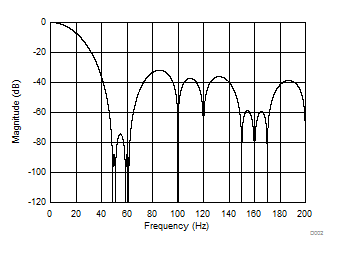 Figure 48. Filter Response
Figure 48. Filter Response
(Normal Mode, DR = 20 SPS)
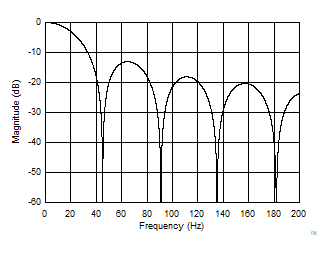 Figure 50. Filter Response
Figure 50. Filter Response
(Normal Mode, DR = 45 SPS)
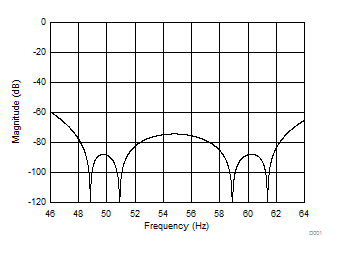 Figure 49. Detailed View of the Filter Response
Figure 49. Detailed View of the Filter Response
(Normal Mode, DR = 20 SPS)
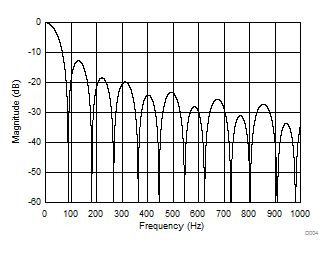 Figure 51. Filter Response
Figure 51. Filter Response
(Normal Mode, DR = 90 SPS)
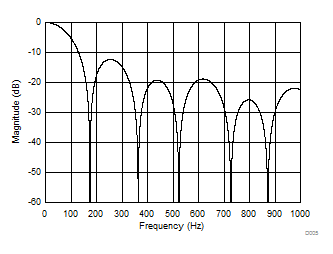 Figure 52. Filter Response
Figure 52. Filter Response
(Normal Mode, DR = 175 SPS)
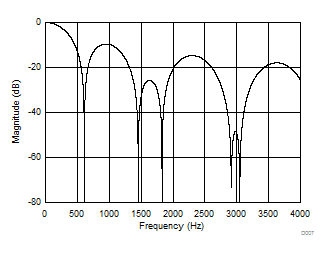 Figure 54. Filter Response
Figure 54. Filter Response
(Normal Mode, DR = 600 SPS)
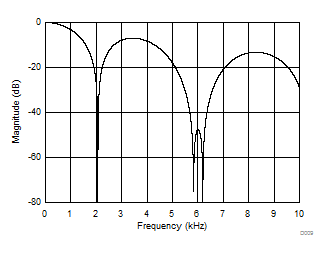 Figure 56. Filter Response
Figure 56. Filter Response
(Turbo Mode, DR = 2 kSPS)
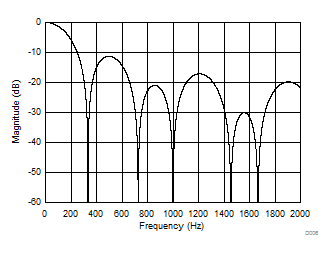 Figure 53. Filter Response
Figure 53. Filter Response
(Normal Mode, DR = 330 SPS)
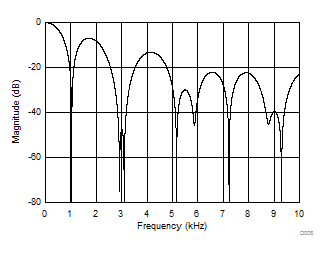 Figure 55. Filter Response
Figure 55. Filter Response
(Normal Mode, DR = 1 kSPS)